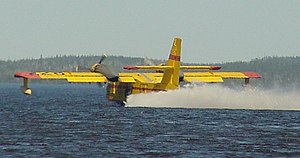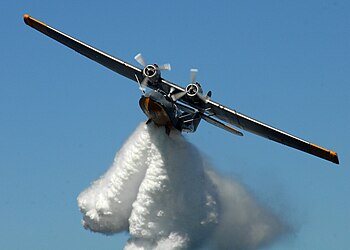Water bomber
A water bomber is an aircraft used in fighting fire, which drops water, or a mixture of water and special fire-fighting additives.
In the USA water bombers are sometimes called "air tankers".
The first aircraft used as water bombers were retrofits. After World War II PBY flying boats were converted to water bombers.[1]

Amphibious aircraft, which can lower a probe and refill their tanks from a nearby lake or reservoir, were the aircraft seen as the best to convert to fight fires.
Canadair was the first company to develop an aircraft designed to be a water bomber - the Canadair 215. This aircraft was introduced in 1969. 125 airframes were sold. 95 more modern Canadair 415s were sold. Viking Air, the firm that bought the intellectual property rights to the designs, in 2018, announced an update, the CL-515.
Russian aircraft firm Beriev introduced a multipurpose amphibious aircraft, the Beriev 200, in 2004, and has sold 20 to serve as firefighting aircraft.
Non-amphibious firefighting aircraft
Non-amphibious firefighting aircraft can not run as many sorties as water-scooping water bombers can. They have to land first, then fill their tanks, then take off.[2] In 2015 the BBC News interviewed one experienced pilot who described how, on one particular day, he managed nine sorties. According to the BBC it takes at least eight minutes to fill the tanks of a DC-10, converted to firefighting. While a water-scooping water bomber can fill its tanks in about ten seconds. In addition, it does not need to wait for traffic control for permission to land or permission to take off
Helicopters used for firefighting
Regular helicopters are also used for firefighting. When engaged in firefighting they hang a fabric bucket underneath, filling it by dipping it in a nearby water source.
References
- ↑ Nola Keeler. Second World War plane with colourful past takes flight in northern Alberta, CBC News, 2017-06-19. Retrieved on 2022-03-25. “After its wartime service, the plane was repurposed as a water bomber and fought fires in the Northwest Territories.”
- ↑ Stephen Dowling. The jaw-dropping missions of fire-fighting pilots, BBC News, 2015-08-21. Retrieved on 2022-03-25. “Hatton says the workload can be intense during a busy fire season. 'We have flown as many as nine times in one day with one crew. The fires that grow to mega status have had as many as 50 of our flights to contain them, but the average is nearer five.' Pilots are restricted to no more than 14 hours on duty, even during the biggest fires, and must have at least two days off every 14 days.”
